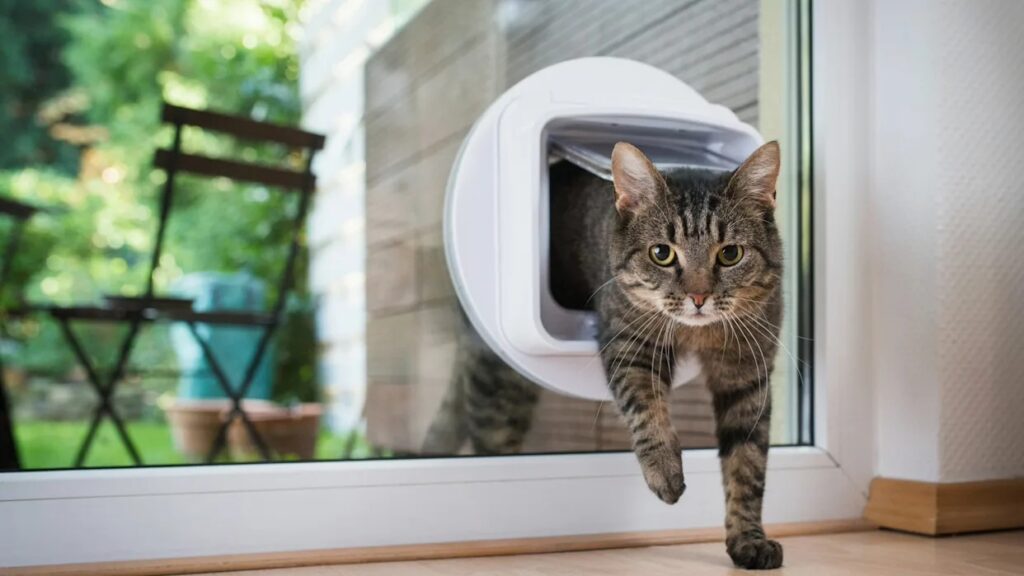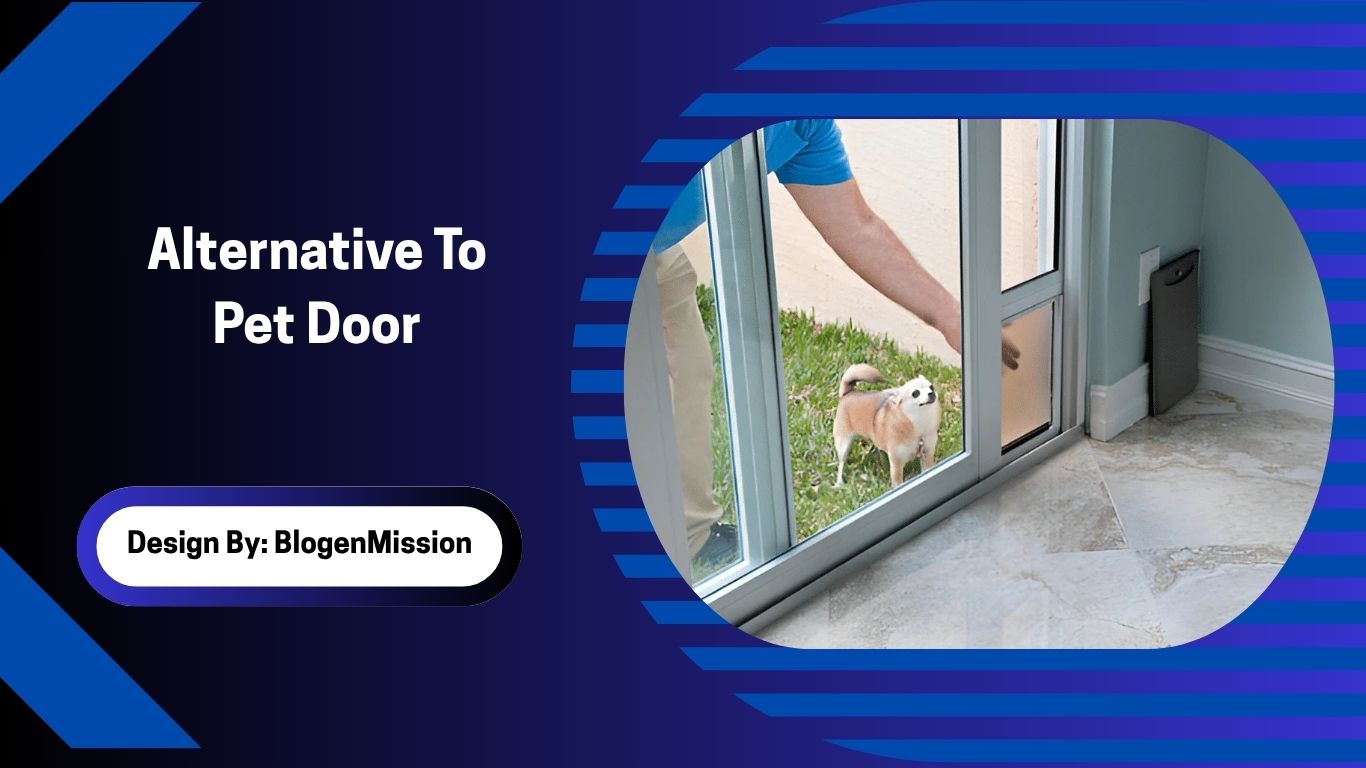Alternatives to pet doors include window flaps ($50–$200), sliding door inserts ($100–$400), smart systems ($150–$500), gates ($30–$150), or DIY solutions ($10–$100) for safe, renter-friendly pet access.
Pet doors are a convenient way to give your furry friends freedom to move in and out of the house, but they’re not always the best fit for every home or pet. Whether you’re renting, concerned about security, or looking for a more modern solution, there are plenty of alternatives to pet doors that balance convenience, safety, and style.
This guide explores innovative and practical options to traditional pet doors, including costs, benefits, and unique ideas to keep your pet happy and your home secure.
Why Consider Alternatives to Pet Doors?
Traditional pet doors, while useful, come with drawbacks. They require cutting into walls or doors, which isn’t ideal for renters or historic homes. Security risks, like unwanted animals or intruders, and weatherproofing issues also prompt pet owners to seek alternatives. Additionally, some pets, like anxious dogs or small cats, may not use pet doors comfortably. Alternatives offer flexibility, affordability, and customization to suit your home and pet’s needs.
Top Alternatives to Pet Doors

Here are the most effective and creative alternatives to pet doors, each offering unique benefits for pet owners and their homes.
1. Window Pet Flaps
Window pet flaps are installed in a window sash, providing a non-invasive alternative to door-based pet flaps. They’re removable, making them ideal for renters.
- Cost: $50–$200, depending on size and features.
- Benefits:
- Easy to install without permanent modifications.
- Suitable for cats and small dogs.
- Often includes locking mechanisms for security.
- Best For: Renters or homes with sliding or sash windows.
- Unique Feature: Some models, like the PetSafe Window Pet Door, include weatherproof seals and UV-resistant materials.
2. Sliding Glass Door Inserts
Sliding glass door inserts are panels with built-in pet flaps that fit into existing patio doors, requiring no drilling or cutting.
- Cost: $100–$400, based on door size and pet flap dimensions.
- Benefits:
- Adjustable to fit most sliding doors.
- Removable for seasonal use or moving.
- High-security options with reinforced frames.
- Best For: Homes with patio doors or larger dogs.
- Unique Data: According to a 2025 survey by PetSafe, 65% of pet owners prefer sliding door inserts for their versatility in multi-pet households.
3. Smart Pet Access Systems
Smart pet access systems use microchip or RFID technology to allow only your pet to enter, enhancing security. These can be installed in windows, walls, or custom frames.
- Cost: $150–$500, including installation and tech setup.
- Benefits:
- Microchip-activated for pet-specific access.
- Smartphone apps monitor pet activity (e.g., SureFlap Microchip Pet Door Connect).
- Programmable timers for controlled access.
- Best For: Tech-savvy owners or homes needing high security.
- Unique Trend: In 2025, smart pet doors integrated with Alexa or Google Home are gaining traction, allowing voice-activated control.
4. Portable Pet Gates with Pass-Throughs
Portable pet gates with small pass-through openings allow pets to move between rooms or outdoor areas without a permanent door modification.
- Cost: $30–$150, depending on material and size.
- Benefits:
- No installation required; easy to move.
- Ideal for indoor use or small yards.
- Adjustable for different pet sizes.
- Best For: Indoor cats or small dogs in apartments.
- Tip: Choose gates with mesh or clear panels for visibility, like the Carlson Pet Gate.
5. DIY Pet Access Solutions
DIY solutions, such as modified window screens or custom pet tunnels, offer budget-friendly and creative alternatives.
- Cost: $10–$100 for materials (e.g., screen mesh, PVC pipes).
- Benefits:
- Fully customizable to your home’s layout.
- Affordable for crafty pet owners.
- Temporary or permanent, depending on design.
- Best For: Handy owners or those with unique home setups.
- Unique Idea: Create a “pet tunnel” using PVC pipes through a basement window, costing under $50, as shared in pet forums like Reddit’s r/PetDIY.
6. Training for Controlled Access
Training your pet to use a designated door or window, opened manually or with a bell system, eliminates the need for a pet door entirely.
- Cost: $0–$50 for training tools (e.g., bells, treats).
- Benefits:
- No structural changes to your home.
- Enhances pet-owner communication.
- Ideal for pets hesitant about flaps.
- Best For: Owners with time to train and small pets.
- Unique Data: A 2025 study by the American Pet Products Association found 30% of pet owners use training-based access solutions for indoor-outdoor transitions.
Costs of Pet Door Alternatives
Here’s a breakdown of costs for alternatives to pet doors, based on national averages and regional variations:
| Alternative | Average Cost | Notes |
| Window Pet Flap | $50–$200 | Includes installation kit. |
| Sliding Glass Door Insert | $100–$400 | Adjustable for most patio doors. |
| Smart Pet Access System | $150–$500 | Includes microchip or app features. |
| Portable Pet Gate | $30–$150 | No installation; indoor/outdoor use. |
| DIY Pet Access Solution | $10–$100 | Materials like mesh or PVC pipes. |
| Training-Based Access | $0–$50 | Bells or treats for training. |
Regional Variations:
- Northeast (e.g., NY, PA): Higher costs for smart systems ($200–$500) due to urban demand.
- South (e.g., TX, FL): More affordable DIY materials ($10–$80) at hardware stores.
- West Coast (e.g., CA): Sliding door inserts popular, costing $120–$350.
Benefits of Pet Door Alternatives
Choosing an alternative to a pet door offers several advantages:
- Flexibility: Most options are removable or non-invasive, ideal for renters or temporary setups.
- Security: Smart systems and locking flaps reduce risks of unwanted entry compared to traditional pet doors.
- Customization: DIY and training options allow tailoring to your pet’s size and behavior.
- Affordability: Options like training or DIY solutions cost significantly less than installing a pet door ($100–$500).
Considerations When Choosing an Alternative
Before selecting an alternative, consider these factors:
- Pet Size and Behavior: Larger dogs may need sliding door inserts, while cats suit window flaps or gates.
- Home Type: Renters should prioritize non-permanent options like gates or inserts.
- Security Needs: Smart systems offer the highest security for urban homes.
- Climate: Weatherproof options, like insulated window flaps, are crucial in extreme climates.
- Budget: Training or DIY solutions are most cost-effective, while smart systems are pricier.
Legal and Safety Considerations
- Rental Agreements: Check with landlords, as permanent modifications (even window flaps) may violate leases.
- Local Regulations: Some areas restrict outdoor pet access due to wildlife or HOA rules; verify local laws.
- Safety: Ensure alternatives have locks or microchip access to prevent stray animals or intruders.
- Pet Safety: Monitor pets during initial use to ensure they adapt comfortably to new access methods.
How to Choose the Right Alternative
- Assess Your Pet’s Needs: Does your pet need outdoor access, or is indoor movement sufficient?
- Evaluate Your Home: Consider door/window types and rental restrictions.
- Set a Budget: Decide if you want a low-cost DIY solution or a premium smart system.
- Research Products: Read reviews on platforms like Amazon or Chewy for durability and ease of use.
- Test and Train: Introduce the alternative gradually, using treats to encourage your pet’s comfort.
Where to Find Pet Door Alternatives
- Online Retailers: Amazon, Chewy, and PetSafe offer window flaps, inserts, and smart systems.
- Pet Stores: Petco and PetSmart stock gates and basic flaps.
- Hardware Stores: Home Depot or Lowe’s provide materials for DIY projects.
- Custom Makers: Etsy sellers offer tailored gates or inserts for unique home setups.
Unique Trends in Pet Access Solutions

- Smart Home Integration: In 2025, brands like SureFlap integrate with smart home systems, allowing voice commands via Alexa to lock/unlock pet access.
- Eco-Friendly Materials: Biodegradable or recycled materials in window flaps and gates are gaining popularity in eco-conscious regions like California.
- Multi-Pet Systems: Sliding door inserts with adjustable flap sizes accommodate households with both cats and dogs, a trend noted in 2025 pet product reports.
Tips for Success with Pet Door Alternatives
- Train Gradually: Use treats and positive reinforcement to help pets adjust to new access points.
- Maintain Security: Regularly check locks or microchip settings to ensure safety.
- Weatherproofing: Add seals or covers to window flaps for insulation in cold or hot climates.
- Monitor Usage: Observe your pet’s behavior to ensure they’re comfortable and safe.
Why Choose an Alternative to a Pet Door?
Alternatives to pet doors provide flexibility, security, and affordability without the need for permanent home modifications. From smart systems to DIY tunnels, these solutions cater to diverse pet and owner needs, ensuring your pet enjoys freedom while your home remains secure and stylish.
FAQs:
1. What is a window pet flap, and how does it work?
A window pet flap is a removable panel installed in a sash window, allowing pets to enter/exit. Costing $50–$200, it’s renter-friendly, secure, and ideal for cats or small dogs.
2. Are smart pet access systems worth the cost?
Smart pet systems ($150–$500) use microchips or apps for pet-specific access, enhancing security. They’re ideal for tech-savvy owners, with features like timers and Alexa integration for convenience.
3. Can I create a DIY pet access solution at home?
Yes, DIY solutions like modified window screens or PVC tunnels cost $10–$100. They’re customizable, budget-friendly, and perfect for unique home layouts, requiring basic materials from hardware stores.
4. Are pet door alternatives safe for large dogs?
Sliding glass door inserts ($100–$400) are safe for large dogs, offering sturdy flaps and locks. Ensure proper sizing and training for comfort, with reinforced frames for added security.
5. Do pet door alternatives work for renters?
Yes, window flaps, portable gates, and sliding door inserts ($30–$400) are renter-friendly, requiring no permanent changes. They’re easily removable, making them ideal for apartments or leased homes.
Conclusion:
Alternatives to pet doors, like window flaps ($50–$200), sliding door inserts ($100–$400), smart systems ($150–$500), or DIY solutions ($10–$100), provide safe, flexible pet access without permanent modifications. Perfect for renters or security-conscious owners, these options suit various pets and budgets. By choosing the right solution, ensuring proper fit, and training your pet, you can enhance their freedom while keeping your home secure and stylish, creating a practical and pet-friendly environment.
